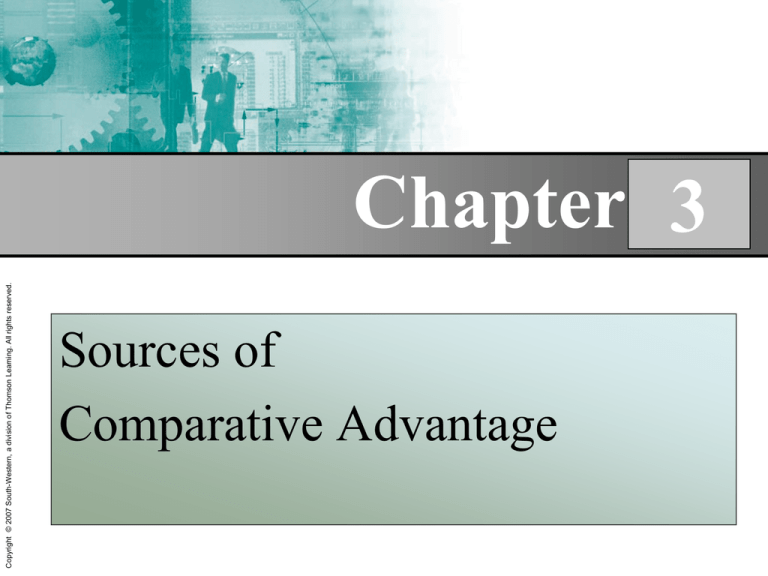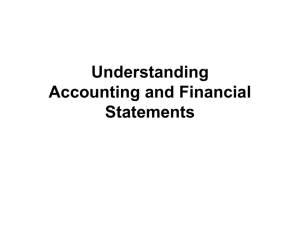
Copyright © 2007 South-Western, a division of Thomson Learning. All rights reserved.
Chapter 3
Sources of
Comparative Advantage
Introduction
Copyright © 2007 South-Western, a division of Thomson Learning. All rights reserved.
• Comparative advantage
– What are the sources of a nation’s
comparative advantage?
Factor Endowments
Copyright © 2007 South-Western, a division of Thomson Learning. All rights reserved.
• Factor-Endowment (Heckscher-Ohlin) Theory
– Explains comparative advantage by differences in
relative national supply conditions
– Key determinant: Resource endowments
– Assumptions:
•
•
•
•
Perfect competition
Same demand conditions
Uniform quality factor inputs
Same technology used
Factor-Endowment Theory
Continued
Copyright © 2007 South-Western, a division of Thomson Learning. All rights reserved.
• Relative price levels differ among nations
because:
– Nations have different relative endowments of
factor inputs
– Different commodities require factor inputs
with differing intensities for production
• Example: Hypothetical resource endowments in
the U.S. and China that are used in the production
of aircraft and textiles (Table 3.1)
• Capital/labor ratios for selected countries (Table 3.2)
Factor-Price Equalization
Copyright © 2007 South-Western, a division of Thomson Learning. All rights reserved.
• Redirecting demand away from the scarce
factor toward the abundant factor
– Cheap factor becomes more expensive;
expensive factor becomes cheaper
– Not fully possible in a real world situation:
• Much income inequality across countries results
from uneven ownership of human capital
• Technology usage not identical
• Transportation costs and trade barriers
– Indexes of hourly compensation (Table 3.3)
Copyright © 2007 South-Western, a division of Thomson Learning. All rights reserved.
Trade and Distribution of Income
• Theoretically, increased trade could
worsen inequalities in wages though this
may benefit national income
– Example: Trade increases the supply of
unskilled labor to the U.S. economy
• Lowers unskilled labor wages for the American
worker
• Calls for protection against import competition
Does Trade Make the Poor Even
Poorer?
Copyright © 2007 South-Western, a division of Thomson Learning. All rights reserved.
• Skilled and unskilled: Widening wage gap
– Factors responsible: trade, technology,
education, immigration, and union weakness
– Determining relative contributions of trade and
other influences on wage discrepancy
• Analytical framework (Figure 3.1) used views this as
an outcome of the interaction between labor supply
and demand
Actual Trade Patterns and
the Factor-Endowment Theory
Copyright © 2007 South-Western, a division of Thomson Learning. All rights reserved.
• Wassily Leontief (1954)
– Data (1947) suggested that capital/labor ratio
for U.S. export industries was lower than that
of its import-competing industries (Table 3.4)
– Conclusion: Exports were less capitalintensive than import-competing goods
– Leontief paradox contradicted the
predictions of the factor-endowment theory
• Study repeated with 1951 data with similar results
Actual Trade Patterns
Continued
Copyright © 2007 South-Western, a division of Thomson Learning. All rights reserved.
• Studies suggest a more generalized
factor-endowment model
– Takes into account many subvarieties of
capital, land, and human factors
– Recognizes that factor endowments change
over time as a result of investment and
technological advances
• Shares of world resources for various countries
and regions in 1993 (Table 3.5)
Actual Trade Patterns
Continued
Copyright © 2007 South-Western, a division of Thomson Learning. All rights reserved.
• Recent researchers
– Focus on the importance of worker skills in
the creation of comparative advantage
• Investments in skill, education, and training, which
enhance a worker’s productivity, create human
capital
• U.S. Human capital relative to other nations (Table
3.6)
Increasing Returns to Scale and
Specialization
Copyright © 2007 South-Western, a division of Thomson Learning. All rights reserved.
• “New trade theory” (1980s)
– Founded on the notion of increasing returns to
scale (economies of scale)
– Nations with similar factor endowments take
advantage of massive economies of scale
• Develop an industry that has economies of scale
• Produce great quantities at low average unit costs
• Trade those low-cost goods to other nations
– Effect of economies of scale on trade (Figure 3.3)
Increasing Returns to Scale
and Specialization Continued
Copyright © 2007 South-Western, a division of Thomson Learning. All rights reserved.
• Cost incentives for specialization
– Benefit from longer production runs,
decreasing average costs
• Home market effect
– Specializing in products with large domestic
demand
• Minimized shipping costs coupled with economies
of scale
• Smaller countries might become deindustrialized
becoming peripheral to the economic core
Overlapping Demands as a Basis
for Trade
Copyright © 2007 South-Western, a division of Thomson Learning. All rights reserved.
• Theory of overlapping demands - Staffan
Linder
– Firms are motivated to manufacture goods
with a large domestic market
• Export is an extension of this production
– Consumer tastes are strongly conditioned by
income levels
– Nations with similar per capita incomes likely
consume similar types of manufactured goods
and will likely trade with each other
Overlapping Demands as a Basis
for Trade
– Potential for trade in manufactured goods
between wealthy and poor nations is small
Copyright © 2007 South-Western, a division of Thomson Learning. All rights reserved.
• Small extent of demand overlap
• Linder’s theory and facts
– High proportion of trade in manufactured
goods takes place among the relatively highincome nations
– Bulk of lower income, developing countries
tend to have more trade with high-income
countries than with lower-income countries
Intraindustry Trade
• Intraindustry specialization
Copyright © 2007 South-Western, a division of Thomson Learning. All rights reserved.
– Opening up of trade: Range of products produced
and sold by each nation changes
• Intraindustry Trade (Examples: Table 3.7)
– Appears to be incompatible with the models of
comparative advantage
– Involves flows of goods with similar factor
requirements
– Reasons for trade in homogeneous goods:
• Transportation costs
• Seasonal
– Most trade occurs in differentiated products
Intraindustry Trade
Continued
Copyright © 2007 South-Western, a division of Thomson Learning. All rights reserved.
• Differentiated products in industrial nations
– “Majority’’ and ‘‘minority’’ consumer tastes
– Overlapping demand segments
• Intraindustry trade is explained by product
differentiation and economies of scale
– Fewer adjustment problems are likely to occur
with specialization
• Transfer of resources from import-competing to
export-expanding sectors
• Lessened problem of structural unemployement
Product Cycle: Technologically
Based Theory of Trade
Copyright © 2007 South-Western, a division of Thomson Learning. All rights reserved.
• Product life cycle theory
– Technological innovation: Key determinant of
trade patterns
– Stages in a trade cycle
•
•
•
•
•
Manufactured good is introduced to home market
Domestic industry shows export strength
Foreign production begins
Domestic industry loses competitive advantage
Import competition begins
– Example: Experience of U.S. and Japanese
manufacturers of radios, pocket calculators
Dynamic Comparative Advantage:
Industrial Policy
Copyright © 2007 South-Western, a division of Thomson Learning. All rights reserved.
• Static nature of Ricardian theory
• Dynamic comparative advantage
– Additional resources can be made available
because they can be created or imported
• Mobilization of skilled labor, technology, and
capital
– In addition to business sector, government
can establish policies to promote
opportunities for change through time
Industrial Policy
Copyright © 2007 South-Western, a division of Thomson Learning. All rights reserved.
• A strategy to revitalize, improve, and
develop an industry
– Requires resources be directed to industries
in which:
• Productivity is highest
• Linkages to the rest of the economy are strong
• Has future competitiveness
– Strategy developed collectively by
government, business, and labor
Industry Policy
Continued
• Advocacy
Copyright © 2007 South-Western, a division of Thomson Learning. All rights reserved.
– The Japanese example
• Criticism
– The causal factor in Japanese industrial success is
unclear
– May lead to trade-inhibiting protectionism
– May favor politically powerful industries
– Raises the question of whether the government does
a better job than the private sector in creating
comparative advantage
Government Regulatory Policies
and Comparative Advantage
Copyright © 2007 South-Western, a division of Thomson Learning. All rights reserved.
• Government regulations to pursue goals:
– Workplace safety
– Product safety
– A clean environment
• Steelmakers complain about regulatory burdens
(Table 3.9)
– Improves the well-being of the public
– Results in higher costs for domestic firms
• Erodes an industry’s competitiveness
• Trade effects of pollution regulations (Figure 3.4)







